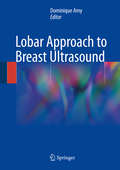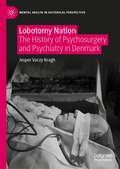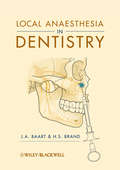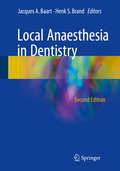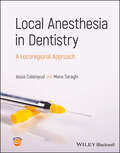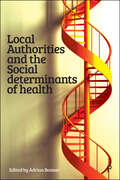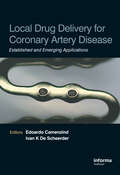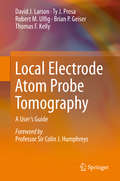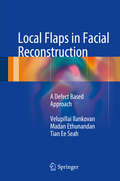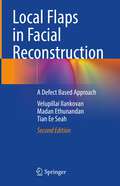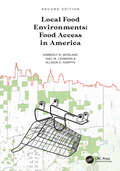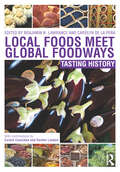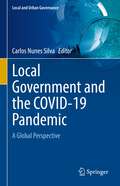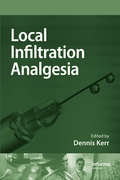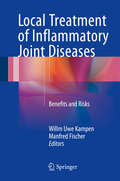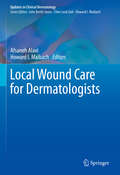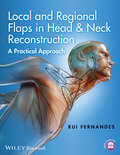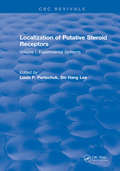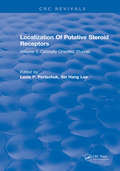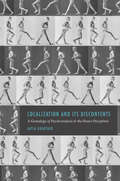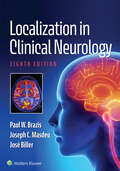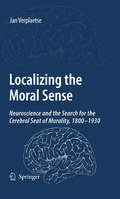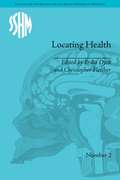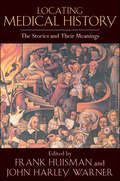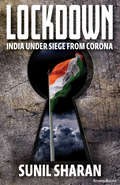- Table View
- List View
Lobar Approach to Breast Ultrasound
by Dominique AmyThis book focuses on the lobar anatomy of the breast and on the sick lobe concept – a novel theory of breast cancer development that is gaining ever wider acceptance – and explores their significance for innovative surgical treatment. Special attention is paid to the role of ductal echography, a technique capable of clearly depicting the structures of cancer in relation to the structures of the sick lobe. Having established a sound theoretical and practical basis through detailed coverage and correlation of anatomy, pathology, and imaging appearances, the book goes on to describe a revolutionary surgical approach particularly suitable for the treatment of multifocal and multicentric breast carcinomas. Such tumors account for more than a third of all cases of breast carcinoma and are often treated by mastectomy. The proposed new breast-conserving technique yields excellent cosmetic results and entails a very low risk of recurrence. The book will appeal to a wide readership, including radiologists, surgeons, oncologists, pathologists, as well as residents.
Lobotomy Nation: The History of Psychosurgery and Psychiatry in Denmark (Mental Health in Historical Perspective)
by Jesper Vaczy KraghThis book tells the story of one of medicine’s most (in)famous treatments: the neurosurgical operation commonly known as lobotomy. Invented by Portuguese neurologist Egas Moniz in 1935, lobotomy or psychosurgery became widely used in a number of countries, including Denmark, where the treatment had a major breakthrough. In fact, evidence suggests that more lobotomies were performed in Denmark than any other country. However, the reason behind this unofficial world record has not yet been fully understood. Lobotomy Nation traces the history of psychosurgery and its ties to other psychiatric treatments such as malaria fever therapy, Cardiazol shock and insulin coma therapy, but it also situates lobotomy within a broader context. The book argues that the rise and fall of lobotomy is not just a story about psychiatry, it is also about society, culture and interventions towards vulnerable groups in the 20th century.
Local Anaesthesia in Dentistry
by J. A. Baart H. S. BrandLocal Anaesthesia in Dentistry is a practical guide for both students and general practitioners to this essential area of clinical practice. Highly illustrated in full colour throughout, the book provides clear and practical guidance to the administration of local anaesthesia. The book introduces the reader to the concept of nerve conduction and pain as well as providing an explanation of the anatomy of the trigeminal nerve. Further chapters cover such key areas of practice as regional anaesthesia, local anaesthesia in children, pharmacology, local and systemic complications, general practical aspects, the prevention of side effects and legal aspects.
Local Anaesthesia in Dentistry
by Jacques A. Baart Henk S. BrandThis book, richly illustrated in full colour, is a comprehensive guide to the use of local anesthesia in dentistry that will meet the needs of both students and dental practitioners. It provides the reader with ample background information on the origin of pain and the pharmacology of anesthetics, and describes the anatomy of the trigeminal nerve in detail. Subsequent chapters cover key are as such as general practical aspects, local anesthesia in the upper and the lower jaw, the use of local anesthetics in children, local and systematic complications, and the prevention of side effects. Patients at particular risk of adverse effects are identified and attention drawn to significant legal aspects. This second edition has been completely revised, with more attention to safety, environment, and sterility. Additional injection techniques have been included, and a new chapter is devoted to microprocessor-assisted administration of anesthetics. Throughout, care has been taken to ensure that the information is clearly presented and the text is easy to read.
Local Anesthesia in Dentistry: A Locoregional Approach
by Jesús Calatayud Mana SaraghiLocal Anesthesia in Dentistry Distills the current body of knowledge in local anesthesia into a single, easy-to-use volume Local Anesthesia in Dentistry: A Locoregional Approach provides comprehensive coverage of all aspects of local anesthetics, including anatomic considerations, pharmacology, armamentarium, injection techniques, indications, contraindications, complications, novel anesthetics formulations, and more. In-depth chapters offer clear criteria and guidelines for patient care, supported by hundreds of evidence-based references. Alongside this, standalone appendixes are hosted on the book’s companion website. In these appendixes, the authors have distilled a wide body of research, summarizing the findings of the seminal studies in the field, including historical landmark studies and clinical trial data to support practical aspects of locoregional anesthesia discussed in the textbook. This easy-to-use volume: Provides students and professionals with a one-stop resource on local anesthesia in dentistry Offers critical evaluations of research and literature on each topic and subtopic Addresses all common local anesthetic techniques, including basic injection, mandibular and maxillary anesthesia, and local anesthesia in children Features practical quantitative data and step-by-step information on situations encountered in daily practice Designed to support all levels of dental professionals, Local Anesthesia in Dentistry: A Locoregional Approach is written by two highly experienced practitioners, making this authoritative resource a must-have for dentists, dental nurses, dental technicians, hygienists, specialists, students, and researchers. It is also a valuable reference for other healthcare providers looking to support future study.
Local Authorities and the Social Determinants of Health
by Adrian BonnerAs many social inequalities widen, this is a crucial survey of local authorities’ evolving role in health, social care and wellbeing. Health and social and public policy experts review structural changes in provision and procurement, and explore social determinants of health including intergenerational needs and housing. With detailed assessments of regional disparities and case studies of effective strategies and interventions from local authorities, this collaborative study addresses complex issues (Wicked Issues), considers where responsibility for wellbeing lies and points the way to future policy-making. The Centre for Partnering (CfP) is a key outcome of this innovative review along with Bonner’s previous work Social Determinants of Health (2017).
Local Drug Delivery for Coronary Artery Disease: Established and Emerging Applications
by Edoardo Camenzind Ivan K De ScheerderPioneers in the field, the editors have assembled an excellent team of contributors with extensive experience of threatened vessel closure and restenosis, acute thrombosis, hyperproliferative cellular response, stents and local drug delivery. Comprehensive and up-to-date, this reference provides fully up-to-date information on currently available methods of drug delivery, as well as illustrations of drug delivery methods with seventy-five color and seventy-five black and white photos throughout the book. With this impressive presentation of the most up-to-date methods and applications, as well as a range of photographs illustrating their implementation, this guide is an excellent resource for cardiologists, pharmacologists, cardiac surgeons, and trainees.
Local Electrode Atom Probe Tomography
by David J. Larson Ty J. Prosa Robert M. Ulfig Brian P. Geiser Thomas F. KellyThis book is the first, single-source guide to successful experiments using the local electrode atom probe (LEAP®) microscope. Coverage is both comprehensive and user friendly, including the fundamentals of preparing specimens for the microscope from a variety of materials, the details of the instrumentation used in data collection, the parameters under which optimal data are collected, the current methods of data reconstruction, and selected methods of data analysis. Tricks of the trade are described that are often learned only through trial and error, allowing users to succeed much more quickly in the challenging areas of specimen preparation and data collection. A closing chapter on applications presents selected, state-of-the-art results using the LEAP microscope.
Local Flaps in Facial Reconstruction
by Velupillai Ilankovan Madan Ethunandan Tian Ee SeahWritten by three experienced consultants with a large skin cancer practice and international reputations for excellence, this book provides comprehensive practical solutions to defects in the head and neck region that are confronted by the clinician in day-to-day practice. Essential information is first provided on anesthesia, defect assessment and individual flaps, while the core chapters focus on the reconstruction of specific defects at specific sites. The defects and reconstructive solutions are depicted by means of sequential, clinically relevant line drawings that are complemented by clear supporting text highlighting the intricacies and nuances of the procedure and the decision-making process. Helpful algorithms at the end of each chapter summarize the solutions. This book will be ideal for use in daily practice by clinicians and trainees and will assist in achieving excellent cosmetic outcomes in this aesthetically sensitive part of the body.
Local Flaps in Facial Reconstruction: A Defect Based Approach
by Velupillai Ilankovan Madan Ethunandan Tian Ee SeahWritten by three consultants with extensive skin cancer experience and international reputations for excellence, this book provides comprehensive practical solutions for defects in the head and neck region that clinicians are confronted with in day-to-day practice. The first edition of the “local flaps in facial reconstruction- a defect base approach” was published nearly four years ago and has since been well received around the world and translated into other languages. This second edition is intended to facilitate the decision-making process and provide practical,step-by-step guidance on reconstructing specific defects in the facial region.The frequency of skin cancer continues to rise around the globe, and clinicians with various backgrounds are involved in the care of these patients. In this book, new procedures are described and “old” ones re-evaluated. The current edition has been extensively updated with new text and diagrams so as to provide comprehensive practical solutions for frequently encountered facial defects. Color diagrams and clinical photographs have been included where necessary to provide additional details. The original ethos of creating a text that can be used in everyday practice, while also including personal comments, is maintained.Given the scope, the book is ideal for use by clinicians and trainees in daily practice, and will help to achieve excellent cosmetic outcomes in this aesthetically sensitive part of the body.
Local Food Environments: Food Access in America
by Kimberly B. Morland Yael M. Lehmann Allison E. Karpyn"In this book, Morland, Lehmann, and Karpyn discuss the critical need for healthy food financing programs as a vehicle to improve food access for all Americans. In my career as a public servant, there are very few legislative achievements that I’m prouder of than the Healthy Food Financing Initiative, which started in my home state of Pennsylvania. The program gained status as a proven and economically sustainable federal program that is helping to improve the quality of life in our neighborhoods: by allowing millions access to healthy, affordable food." – Congressman Dwight Evans United States House of Representatives, Pennsylvania, District 3 "If we work together, we can create a healthy food system that is equitable and accessible to all. This book highlights the importance of healthy food projects like grocery stores, farmers markets, co-ops, and other healthy food retail in revitalizing local communities across the country. Without basic nourishment, kids and families simply won’t be successful – which is why this book is a must read." – Sam Kass President Obama’s Senior Nutrition Policy Advisor and Executive Director of Let’s Move! "Morland and colleagues’ new second edition provides an excellent foundation for courses in food policy and community nutrition. Their detailed review of the economics of local and national food financing will open students’ minds to the complexity inherent in measuring and interpreting outcomes." – Robert S. Lawrence, MD, MACP Founder and Former Director of the Center for a Livable Future Johns Hopkins University, Bloomberg School of Public Health Features ● Describes how disparities in food access formed in the United States ● Includes federal policies and programs aimed at addressing food access in underserved areas, including the Healthy Food Financing Initiative ● Features examples of state initiatives that address poor access to food retailers ● Provides methods for program evaluation utilizing principals of implementation and dissemination science ● Includes critical thinking questions and embedded videos aimed to generate discussions on how restricted local food environments in the United States are rooted in economic disparities that impact food access as well as housing, education, and job opportunities
Local Foods Meet Global Foodways: Tasting History
by Benjamin N. Lawrance Carolyn de la PeñaThis book explores the intersection of food and foodways from global and local perspectives. The collection contributes to interdisciplinary debates about the role and movement of commodities in the historical and contemporary world. The expert contributions collectively address a fundamental tension in the emerging scholarly terrain of food studies, namely theorizing the relationship between foodstuff production and cuisine patterns. They explore a wide variety of topics, including curry, bread, sugar, coffee, milk, pulque, Virginia ham, fast-food, obesity, and US ethnic restaurants. Local Foods Meet Global Foodways considers movements in context, and, in doing so, complicates the notions that food 'shapes' culture as it crosses borders or that culture 'adapts' foods to its neo-local or global contexts. By analysing the dynamics of contact between mobile foods and/or people and the specific cultures of consumption they provoke, these case studies reveal the process whereby local foods become global or global foods become local, to be a dynamic, co-creative development jointly facilitated by humans and nature. This volume explores a vast expanse of global regions, such as North and Central America, Europe, China, East Asia and the Pacific, India, sub-Saharan Africa, the Atlantic Ocean, and the USSR/Russia. It includes a foreword by the eminent food scholar Carole Counihan, and an afterword by noted theorist of cuisine Rachel Laudan, and will be of great interest to students and researchers of history, anthropology, geography, cultural studies and American studies. This book is based on a special issue of Food and Foodways.
Local Government and the COVID-19 Pandemic: A Global Perspective (Local and Urban Governance)
by Carlos Nunes SilvaThe book provides a global perspective of local government response towards the COVID-19 pandemic through the analysis of a sample of countries in all continents. It examines the responses of local government, as well as the responses local government developed in articulation with other tiers of government and with civil society organizations, and explores the social, economic and policy impacts of the pandemic. The book offers an innovative contribution on the role of local government during the pandemic and discusses lessons for the future. The COVID-19 pandemic had a global impact on public health, in the well-being of citizens, in the economy, on civic life, in the provision of public services, and in the governance of cities and other human settlements, although in an uneven form across countries, cities and local communities. Cities and local governments have been acting decisively to apply the policy measures defined at national level to the specific local conditions. COVID-19 has exposed the inadequacy of the crisis response infrastructures and policies at both national and local levels in these countries as well as in many others across the world. But it also exposed much broader and deeper weaknesses that result from how societies are organized, namely the insecure life a substantial proportion of citizens have, as a result of economic and social policies followed in previous decades, which accentuated the impacts of the lockdown measures on employment, income, housing, among a myriad of other social dimensions. Besides the analysis of how governments, and local government, responded to the public health issues raised by the spread of the virus, the book deals also with the diversity of responses local governments have adopted and implemented in the countries, regions, cities and metropolitan areas. The analysis of these policy responses indicates that previously unthinkable policies can surprisingly be implemented at both national and local levels.
Local Infiltration Analgesia: A Technique to Improve Outcomes after Hip, Knee or Lumbar Spine Surgery
by Dennis R. KerrThe concept of integrating pain management into the surgical process as a single entity is new and exciting. The use of local anaesthetic to block post-operative pain at the site of its generation is here refined into a management program allowing early mobilisation and dramatic pain control in the early post-operative period. This multimodal techn
Local Treatment of Inflammatory Joint Diseases
by Willm Uwe Kampen Manfred FischerThis book presents a systematic survey of different local treatments in inflammatory joint diseases and their potential side effects and complications. Both surgical therapies and pharmaceutical strategies involving local or systemic application of anti-inflammatory and immunomodulating drugs are addressed. Special emphasis is placed on nuclear medicine therapy by intra-articular instillation of beta radiation emitters, known as radiosynoviorthesis or radiation synovectomy. Possible complications, in particular radionecrosis, infection, and thromboembolism, are described and available treatment strategies are examined in detail. In addition, radiation safety considerations are critically reviewed and relevant clinical questions are discussed. While radiosynoviorthesis is an effective and safe treatment if a proper indication is secured and if the application is performed by an experienced nuclear medicine physician, local complications can never be excluded with certainty. This book will support physicians who are engaged in the care and treatment of patients with inflammatory joint disease, approximately 30,000 of whom undergo radiosynoviorthesis in Europe each year.
Local Wound Care for Dermatologists (Updates in Clinical Dermatology)
by Howard I. Maibach Afsaneh AlaviFocusing on local wound care specifically for the dermatologist, this concise text provides a go-to source for practitioners looking for a quick solution for many of the most common wounds as well as an update on what's new in the field. From the most basic principles of local wound care to a look at what upcoming therapies like stem cells and lasers can do, this text is comprehensive and informed. Providing quality local wound care requires an ample knowledge of available products, their cost effectiveness, and the principles for the optimal interventions; Local Wound Care for Dermatologists includes these three guiding points in each chapter that focuses on a specific therapy. Expertly written text is accompanied by multiple tables of drug-specific names, current price points, and comparable products. Chapters include many color images, thereby providing insight to a given wound and the various therapies available to treat it. While the basics are reviewed in the opening chapters, later chapters feature updates in therapies including discussions on what's new in skin substitutes, negative pressure wound therapy, oxygen therapy, and an update in cell based therapy. Written with the dermatologist in mind, Local Wound Care for Dermatologists is an indispensable reference for students, residents, and practicing doctors alike. General practitioners and plastic surgeons will also find this title a useful refresher.
Local and Regional Flaps in Head & Neck Reconstruction: A Practical Approach
by Rui FernandesLocal and Regional Flaps in Head & Neck Reconstruction: A Practical Approach provides comprehensive, step-by-step instruction for flap raising and insetting for the head and neck region. Ideal for oral and maxillofacial surgeons, facial plastic surgeons, and head and neck surgeons, the book serves as a useful guide to planning reconstructive cases and an easily accessible reference prior to operation.Local and Regional Flaps in Head & Neck Reconstruction is logically organized into 24 chapters, each focusing on a local or regional flap, or a special site reconstruction. Chapters focused on a particular flap will begin with a detailed description of the relevant anatomy and discuss potential applications of the flap before moving into a detailed step-by-step description of how to elevated and transfer the flap to the defect site. Potential complications will also be addressed.Well-illustrated with more than 800 clinical photographs and with a website featuring surgical procedures, this book is an ideal reference for those new to practice and experts alike.
Localization Of Putative Steroid Receptors: Volume I: Experimental Systems
by Louis P. PertschukThese volumes represent the "state-of-the-art" in morphological methods for detection of steroid receptors. In Volume I we have attempted to collect current available methods and experimental approahes which might be useful in solving present enigmas. The background and recent advances presented are intended to stimulate further experimentation and new innovations, and spur clinical trials by all investigators with an interest in steroid hormones, cell biology, and clinical oncology.
Localization Of Putative Steroid Receptors: Volume II: Clinically Oriented Studies
by PertschukThese volumes represent the "state-of-the-art" in morphological methods for detection of steroid receptors. Some physician authors have applied many of the new methodologies in clinical research projects deisgned to improve medical practice, and these attempts have been placed in Volume II. The Background and recent advances presented here are intended to stimulate further experimentation and new innovations, and spur clinical trials by all investigators with an interest in steroid hormones, cell biology, and clinical oncology.
Localization and Its Discontents: A Genealogy of Psychoanalysis & the Neuro Disciplines
by Katja GuentherPsychoanalysis and neurological medicine have promoted contrasting and seemingly irreconcilable notions of the modern self. Since Freud, psychoanalysts have relied on the spoken word in a therapeutic practice that has revolutionized our understanding of the mind. Neurologists and neurosurgeons, meanwhile, have used material apparatus—the scalpel, the electrode—to probe the workings of the nervous system, and in so doing have radically reshaped our understanding of the brain. Both operate in vastly different institutional and cultural contexts. Given these differences, it is remarkable that both fields found resources for their development in the same tradition of late nineteenth-century German medicine: neuropsychiatry. In Localization and Its Discontents, Katja Guenther investigates the significance of this common history, drawing on extensive archival research in seven countries, institutional analysis, and close examination of the practical conditions of scientific and clinical work. Her remarkable accomplishment not only reframes the history of psychoanalysis and the neuro disciplines, but also offers us new ways of thinking about their future.
Localization in Clinical Neurology
by Jose Biller Paul W. Brazis Joseph C. MasdeuAnatomical localization skills based in physical examination are essential for any clinician caring for patients with neurologic disease processes. Now fully revised and up to date, Localization in Clinical Neurology, 8th Edition, uses easy-to-read descriptions, full-color illustrations and videos to help readers understand and locate the source of a patient’s signs and symptoms. This gold standard text now features dozens of clinical videos that help clinicians improve diagnostic accuracy and avoid unnecessary testing.
Localizing the Moral Sense
by Jan VerplaetseDue to the current revolution in brain research the search for the "moral brain" became a serious endeavour. Nowadays, neural circuits that are indispensable for moral and social behaviour are discovered and the brains of psychopaths and criminals - the classical anti-heroes of morality - are scanned with curiosity, even enthusiasm. How revolutionary this current research might be, the quest for a localisable ethical centre or moral organ is far from new. The moral brain was a recurrent theme in the works of neuroscientists during the 19th and 20th century. From the phrenology era to the encephalitis pandemic in the 1920s a wide range of European and American scientists (neurologists, psychiatrists, anthropologists and criminologists) speculated about and discussed the location of a moral sense in the human cortex. Encouraged by medical discoveries and concerned by terrifying phenomena like crime or "moral insanity" (psychopathy) even renowned and outstanding neurologists, including Moritz Benedikt, Paul Flechsig, Arthur Van Gehuchten, Oskar Vogt or Constantin von Monakow, had the nerve to make their speculations public. This book presents the first overview of believers and disbelievers in a cerebral seat of human morality, their positions and arguments and offers an explanation for these historical attempts to localise our moral sense, in spite of the massive disapproving commentary launched by colleagues.
Locating Health: Historical and Anthropological Investigations of Place and Health (Studies for the Society for the Social History of Medicine #2)
by Erika Dyck Christopher FletcherThe essays in this collection focus on the dynamic relationship between health and place. Historical and anthropological perspectives are presented – each discipline having a long tradition of engaging with these concepts. The resulting dialogue should produce a new layer of methodology, enhancing both fields.
Locating Medical History: The Stories and Their Meanings
by Frank Huisman and John Harley WarnerThe issues constituting the history of medicine are consequential: how societies organize health care, how individuals or states relate to sickness, how we understand our own identity and agency as sufferers or healers. In Locating Medical History: The Stories and Their Meanings, Frank Huisman, John Harley Warner, and other eminent historians explore and reflect on a field that accommodates a remarkable diversity of practitioners and approaches.At a time when medical history is facing profound choices about its future, these scholars explore the discipline in the distant and recent past in order to rethink its missions and methods today. They discuss such issues as the periodic estrangement of medical history from medicine, the influence of Foucault on the writing of medical history, and the shifts from social to cultural history and back again. Chapters explore the early history of the field, its transformations since the 1970s, and its prospects for the future.With diverse constituencies, a multiplicity of approaches, styles, and aims is both expected and desired. This volume locates medical history within itself and within larger historiographic trends, to provide a springboard for discussions about what the history of medicine should be, and what aims it should serve.Contributors: Olga Amsterdamska, University of Amsterdam; Warwick Anderson, University of Wisconsin, Madison; Allan M. Brandt, Harvard Medical School; Theodore M. Brown, University of Rochester; Roger Cooter, University College London; Martin Dinges, Institut für Geschichte der Medizin der Robert Bosch Stiftung; Alice Domurat Dreger, Michigan State University; Jacalyn Duffin, Queen's University; Elizabeth Fee, National Library of Medicine; Mary E. Fissell, The Johns Hopkins University; Danielle Gourevitch, École Pratique des Hautes Études; Anja Hiddinga, University of Amsterdam; Ludmilla Jordanova, University of East Anglia; Alfons Labisch, Heinrich-Heine-University; Hans-Uwe Lammel, University of Rostock; Sherwin B. Nuland, Yale University; Vivian Nutton, University College London; Roy Porter, formerly University College London; Susan M. Reverby. Wellesley College; David Rosner, Columbia University; Thomas Rütten, University of Newcastle upon Tyne; Heinz-Peter Schmiedebach, University of Greifswald; Christiane Sinding, Institut National de la Santé et de la Recherche Médicale
Lockdown: India Under Siege from Corona
by Sunil SharanThe respected Times of India journalist reveals the truths and consequences of the country&’s unprecedented COVID-19 lockdown. On March 24, 2020, with approximately five hundred reported COVID-19 cases reported and only hours notice, India&’s Prime Minister Narendra Modi ordered the most stringent national lockdown the world has ever seen. Two months later, Modi announced the fourth phase of national lockdown with some relaxations. Now in phase five of lockdown—and as restrictions are loosened even more—all everyone knows for sure is what is unknown: What happens to the virus as India reopens? What happens to the Indian economy? And what happens to Modi? Lockdown brings you inside an event that will affect the world around us perhaps for decades to come.
